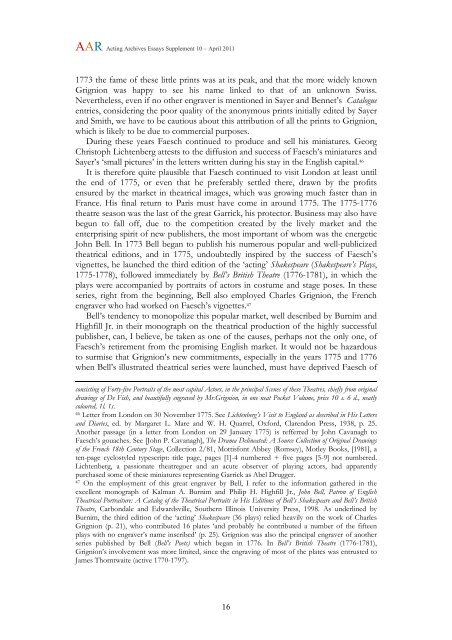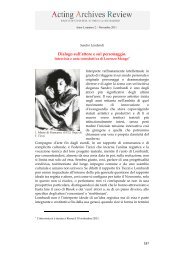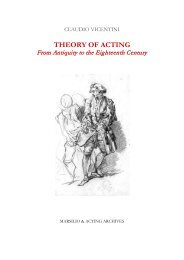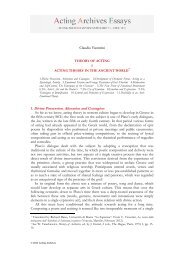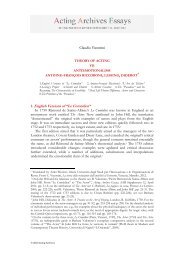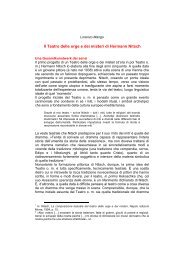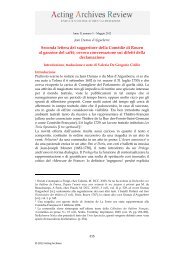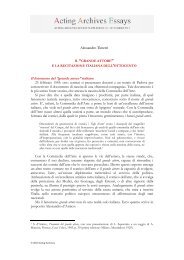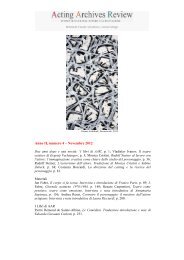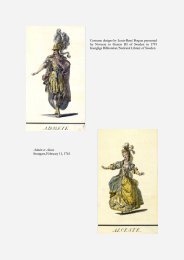Maria Ines Aliverti_The Miniatures of Jean Louis ... - Acting Archives
Maria Ines Aliverti_The Miniatures of Jean Louis ... - Acting Archives
Maria Ines Aliverti_The Miniatures of Jean Louis ... - Acting Archives
Create successful ePaper yourself
Turn your PDF publications into a flip-book with our unique Google optimized e-Paper software.
AAR <strong>Acting</strong> <strong>Archives</strong> Essays Supplement 10 – April 2011<br />
1773 the fame <strong>of</strong> these little prints was at its peak, and that the more widely known<br />
Grignion was happy to see his name linked to that <strong>of</strong> an unknown Swiss.<br />
Nevertheless, even if no other engraver is mentioned in Sayer and Bennet’s Catalogue<br />
entries, considering the poor quality <strong>of</strong> the anonymous prints initially edited by Sayer<br />
and Smith, we have to be cautious about this attribution <strong>of</strong> all the prints to Grignion,<br />
which is likely to be due to commercial purposes.<br />
During these years Faesch continued to produce and sell his miniatures. Georg<br />
Christoph Lichtenberg attests to the diffusion and success <strong>of</strong> Faesch’s miniatures and<br />
Sayer’s ‘small pictures’ in the letters written during his stay in the English capital. 46<br />
It is therefore quite plausible that Faesch continued to visit London at least until<br />
the end <strong>of</strong> 1775, or even that he preferably settled there, drawn by the pr<strong>of</strong>its<br />
ensured by the market in theatrical images, which was growing much faster than in<br />
France. His final return to Paris must have come in around 1775. <strong>The</strong> 1775-1776<br />
theatre season was the last <strong>of</strong> the great Garrick, his protector. Business may also have<br />
begun to fall <strong>of</strong>f, due to the competition created by the lively market and the<br />
enterprising spirit <strong>of</strong> new publishers, the most important <strong>of</strong> whom was the energetic<br />
John Bell. In 1773 Bell began to publish his numerous popular and well-publicized<br />
theatrical editions, and in 1775, undoubtedly inspired by the success <strong>of</strong> Faesch’s<br />
vignettes, he launched the third edition <strong>of</strong> the ‘acting’ Shakespeare (Shakespeare’s Plays,<br />
1775-1778), followed immediately by Bell’s British <strong>The</strong>atre (1776-1781), in which the<br />
plays were accompanied by portraits <strong>of</strong> actors in costume and stage poses. In these<br />
series, right from the beginning, Bell also employed Charles Grignion, the French<br />
engraver who had worked on Faesch’s vignettes. 47<br />
Bell’s tendency to monopolize this popular market, well described by Burnim and<br />
Highfill Jr. in their monograph on the theatrical production <strong>of</strong> the highly successful<br />
publisher, can, I believe, be taken as one <strong>of</strong> the causes, perhaps not the only one, <strong>of</strong><br />
Faesch’s retirement from the promising English market. It would not be hazardous<br />
to surmise that Grignion’s new commitments, especially in the years 1775 and 1776<br />
when Bell’s illustrated theatrical series were launched, must have deprived Faesch <strong>of</strong><br />
consisting <strong>of</strong> Forty-five Portraits <strong>of</strong> the most capital Actors, in the principal Scenes <strong>of</strong> these <strong>The</strong>atres, chiefly from original<br />
drawings <strong>of</strong> De Fish, and beautifully engraved by Mr.Grignion, in one neat Pocket Volume, price 10 s. 6 d., neatly<br />
coloured, 1l. 1s.<br />
46 Letter from London on 30 November 1775. See Lichtenberg’s Visit to England as described in His Letters<br />
and Diaries, ed. by Margaret L. Mare and W. H. Quarrel, Oxford, Clarendon Press, 1938, p. 25.<br />
Another passage (in a letter from London on 29 January 1775) is refferred by John Cavanagh to<br />
Faesch’s gouaches. See [John P. Cavanagh], <strong>The</strong> Drama Delineated: A Source Collection <strong>of</strong> Original Drawings<br />
<strong>of</strong> the French 18th Century Stage, Collection 2/81, Mottisfont Abbey (Romsey), Motley Books, [1981], a<br />
ten-page cyclostyled typescript: title page, pages [1]-4 numbered + five pages [5-9] not numbered.<br />
Lichtenberg, a passionate theatregoer and an acute observer <strong>of</strong> playing actors, had apparently<br />
purchased some <strong>of</strong> these miniatures representing Garrick as Abel Drugger.<br />
47 On the employment <strong>of</strong> this great engraver by Bell, I refer to the information gathered in the<br />
excellent monograph <strong>of</strong> Kalman A. Burnim and Philip H. Highfill Jr., John Bell, Patron <strong>of</strong> English<br />
<strong>The</strong>atrical Portraiture: A Catalog <strong>of</strong> the <strong>The</strong>atrical Portraits in His Editions <strong>of</strong> Bell’s Shakespeare and Bell’s British<br />
<strong>The</strong>atre, Carbondale and Edwardsville, Southern Illinois University Press, 1998. As underlined by<br />
Burnim, the third edition <strong>of</strong> the ‘acting’ Shakespeare (36 plays) relied heavily on the work <strong>of</strong> Charles<br />
Grignion (p. 21), who contributed 16 plates ‘and probably he contributed a number <strong>of</strong> the fifteen<br />
plays with no engraver’s name inscribed’ (p. 25). Grignion was also the principal engraver <strong>of</strong> another<br />
series published by Bell (Bell’s Poets) which began in 1776. In Bell’s British <strong>The</strong>atre (1776-1781),<br />
Grignion’s involvement was more limited, since the engraving <strong>of</strong> most <strong>of</strong> the plates was entrusted to<br />
James Thorntwaite (active 1770-1797).<br />
16


